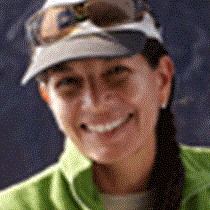Bartolomé and Rabida Islands
Early in the morning we landed at Bartolomé, a lovely volcanic islet just off the east coast of Santiago Island, the fourth largest of the Galápagos Islands.
As we started our early morning hike we saw a Galápagos snake, well camouflaged in the sandy soil, waiting for its prey, probably a distracted lava lizard. And on the way up to the top of the island, we were surprised by a young hawk that approached us attracted by my blue bandana…it landed right in the middle of two groups, just a couple of feet from us and started grabbing the blue bandana while hundreds of pictures were taken. An unexpected encounter!
The view at the top is worth every breath. A volcanic moonscape of rust-colored "spatter cones" contrasts with large pale tuff cones and sooty lava flows, where few plant species, such us the Tiquilia nesiotica and lava cactus can withstand the drought conditions that occur here.
After breakfast and a safety briefing about snorkeling and kayaking, we were ready to jump in the water for our first deep-water snorkel. With the underwater camera in my hand, we went around the Pinnacle Rock where we found a myriad of colorful reef fish as well as sea stars, barnacles, and corals.
Once all were on board, we weighed anchor immediately and started sailing west towards Rabida Island (formerly known as Jervis). Here we offered two options: Explore the shores of Rabida by kayaking or the underwater world while snorkeling. Again, both activities were fantastic. During the snorkel, we spotted marine iguanas feeding. They were so busy that they did not pay any attention to us while we were filming or taking pictures just a few feet from them. Then, we spotted a Pacific green sea turtle that looked more yellow than green, therefore it was the yellow morph type of this species. Immediately after, we encountered a quite big female white-tipped reef shark and I was able to film it very close as it passed just few feet away from us. Then, a red spiny lobster came out of a rock displaying its beautiful red-orange colors, while yellow-tailed damselfish, parrotfish, giant hieroglyphic hawk fish, yellow-tailed razors, and wrasses were everywhere.
Later we went for a walk on one of the most unusual beaches in Galápagos, a red one, as the sand in this island is made from lava with high iron oxide content. Sea lions were resting on the beach, either sleeping, resting or feeding their pups, and just about when we were ready to leave, flamingos came into the brackish lagoon, displaying their very bright pink colors while feeding very close to us.
We couldn’t be more spoiled, in just a single day, we saw everything we could possible see!




